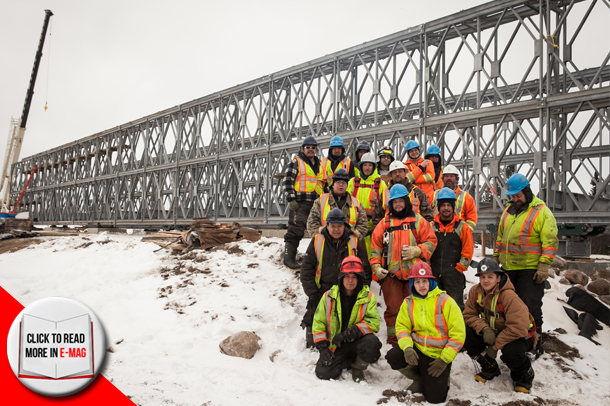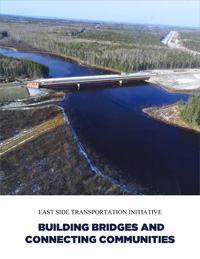Building Bridges and Connecting Communities
By: Mudeeha Yousaf
The Government of Manitoba announced in its November 2008 Throne Speech that the Manitoba Floodway Authority (MFA) will be given authority to construct an all-season road on the east side of Lake Winnipeg. The East Side Transportation Initiative (ESTI) is a strategic project to allow an improved transportation system for the 36, 000 residents who live in this remote area. It is with this premise that Bill 31, the Manitoba Floodway Authority Act, was born and established the Manitoba Floodway and East Side Road Authority (MFESRA) – the provincial agency managing the project – full responsibility for the maintenance of the all-season road in the region. As part of their mandate, the ESRA has signed community benefit agreements with thirteen First Nations communities in order to generate jobs, training, economic development opportunities and an overall improved quality of life for local residents.
Forming the Initiative:
The ESTI aims to link up isolated communities on the eastside of Lake Winnipeg, sparked by a greater need for these First Nations communities to be connected to the outside world and to address the impacts of Climate Change on winter roads. “Our plan is to make strategic improvements to the winter road system to make it last longer,” advocates Ernie Gilroy, CEO of the ESRA. Gilroy, who has dabbled into Manitoba’s political circle as a member of Winnipeg’s City Council and worked alongside the Provincial and Federal Government, uses his vast experience to help guide the venture. Prior to taking on the all-season road project, Gilroy spearheaded the Red River Floodway Expansion Project – a massive flood protection project for the City of Winnipeg – which was delivered on time and under budget by $38 million.
The all-season road project is also a massive undertaking. Estimated at $3 billion (2011$), the initiative is a long-term haul and is approximated to take over 30 years to fortify. “Because the Federal Government has not yet committed to the project, we`re proceeding on the basis of the provincial commitment to the project,” says Eric Robinson, Minister of Aboriginal and Northern Affairs and vital member in the Manitoba Legislature. .
In the past, governments have turned a blind eye towards the dire need for these communities to implement an all-seasons road network. As a result, these communities rely on a short winter road season to bring in much needed food, fuel and construction materials into their communities. When the winter road seizes to operate and when the rivers start to thaw, these individuals are left immobile and resource less. The initiative is implementing an upgrade to the previous winter road system through Acrow panel bridges. These bridges will help to lengthen the time residents and commercial truckers can use the winter roads. Over time, ESRA is also planning to convert winter roads into pioneer roads, which are low-speed limit roads, into an all-season road. To date, the initiative has constructed 42km of an all season road. Work on the Bloodvein River Bridge is currently underway and once completed, scheduled for this Fall, Bloodvein First Nation will be the first East Side remote community to be linked to the rest of the province. We can expect to see more First Nations join in over the next few years.
“Had we had a financial commitment from the Federal Government it would be a lot faster, but since we are using Provincial resources it is going to take longer to finish the project. Nevertheless we are proceeding,” says Robinson. Previously, the Federal Government did contribute to a $3 million access road pilot project to connect Bloodvein to the all-season road. Discussions are ongoing for similar commitments for other First Nation communities that will require access roads to an all-season road.
Benefits of Initiative:
As well as providing exposure to the issue of denied accessibility to those isolated Aboriginal communities not able to reach parts of their Provincial home, the initiative will also seek to rectify other significant issues. The project hopes to enhance access to emergency, health and social services, greater mobility through a reliable transportation network and a sustainable economic development plan, which includes stable employment for citizens as well as tourism and resource development.
Building Economic Stability:
“A major part of our mandate is to create sustainable economic development opportunities for the people in the communities. There has been some dissatisfaction from First Nations communities in regards to governments, and we are working to build back trust,” says Gilroy. “Our plan is to, over a period of time, hire these communities to produce the materials needed for the project and it is critical to that process that we have positive relationships with those communities.” The ESRA is keen on making sure these individuals not only receive assistance, but also acquire the skills needed to thrive in society – to be able to provide for their families on their own merit and capabilities. The initiative will help to build capacity in the communities so that they will be able to become major players in the construction and maintenance of the all-season road. This will have a long-term economic benefit for the communities.
Not only will these communities supply the materials for the project but they will also help with strategic improvements to the roads in order to generate “pay cheques in people’s pockets.” In addition, when the ESRA goes out to tenders, the bidders agree to hire a significant number of people locally and sign agreements to purchase goods and products from these local establishments as well as providing training opportunities. “Once these roads are built, it is our intention to hire the local community to maintain them, not simply for jobs in the short-term, but sustainable economic development,” says Gilroy. “Building relationships are very important for us.”
Protecting the Environment:
Aligning the East Side Road with the winter roads will work to preserve and protect the land these communities hold sacred. For example, every effort is being made to follow the existing winter road alignment for the new all-season road, thereby limiting the amount of forest land that has to be impacted. Further to this, the Government of Manitoba is supporting the application for a UN Heritage Designation, an application to declare the Boreal Forest Area on the east side as a historic designation to be preserved. “The communities want this road to be built in a manner that is consistent with the Heritage Designation and we take our environmental responsibilities seriously,” says Gilroy. As well, the ESRA monitors wildlife in the region including caribou, moose, wolves and other fur bearing species as well as specialized soil, fish, vegetation, archaeological studies to make sure they are not damaging any part of the ecosystem. The locals work simultaneously with the crew to show them the sacred sites, burial grounds and archeological locations so these areas are unspoiled.
“There are many challenges when working in a unique region such as the east side, said Gilroy . “It is our challenge to make sure we do this in a responsible way that protects the integrity of the environment.” Gilroy noted that MFESRA’s record is second to none in Manitoba.
Building for the future:
Though the Manitoba Floodway and East Side Road Authority are making momentous strides in this significant economic revitalization project for Manitoba`s landscape, a greater awareness must be issued calling to action both Provincial and Federal government aid to break past barriers of segregation. Robinson closes, “all other Canadians are connected to roads and we should be giving consideration to our fellow citizens of the province by providing them the same opportunity — and that is accessibility to the bigger world.”
For more information on the ESRI, visit http://www.eastsideroadauthority.mb.ca/







